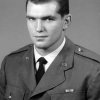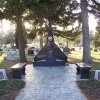Sijan was born in Milwaukee, Wisconsin in 1942 from a Serbian father and Irish mother. He graduated from the United States Air Force Academy in 1965, and after attending pilot training, was assigned to the 366th Wing at Da Nang Air Base, Vietnam.
.On his 52nd mission, on the night of November 9th, 1967, Sijan and pilot Lt. Col. John Armstrong were tasked with a bombing mission over North Vietnam. As they rolled in on their target to release their ordnance, their F-4C was engulfed in a ball of fire and entered a banking climb before plunging into the jungle below. Sijan ejected from his aircraft, and a search-and-rescue crew radioed that they were sending down someone to assist him. Refusing to put another person in danger, he asked that a penetrator be lowered instead. However, he couldn't grab the dropped steel cable, and after 33 minutes the rescue team faced enemy fire and had to leave. Wounded and without food, water, or his survival kit, Sijan evaded enemy forces for 46 days before being captured on December 25th, 1967. Although emaciated and in poor shape, he managed to overpower his guard and escape, but was recaptured within hours. He was transported to a holding compound in Vinh, North Vietnam, where he was put into the care of other American POWs. After further travel to Hanoi, Sijan succumbed to his wounds, exhaustion, and disease, and he died in captivity on January 22nd, 1968.
Sijan was promoted posthumously to captain on June 13th, 1968. His remains were repatriated and positively identified in 1974. He is buried in Arlington Park Cemetery in Milwaukee, Wisconsin. For his bravery, Captain Sijan was posthumously awarded the Congressional Medal of Honor. On March 4 th, 1976, President Gerald Ford presented Captain Sijan's Congressional Medal of Honor to his parents, Sylvester and Jane.
The Air Force created the Lance P. Sijan Award, recognizing individuals who have demonstrated the highest qualities of leadership in their jobs and in their lives. It has become one the U.S. Air Force's most prestigious awards. Because Sijan was the first graduate of the US Air Force Academy to be awarded the Congressional Medal of Honor, a cadet dormitory, Sijan Hall was named after him. As part of their training, all fourth-class (freshman) cadets at the Air Force Academy are expected to learn Sijan's story.
Lance Peter Sijan (Serbian: Лазар Шијан/Lazar Šijan) (April 13, 1942 – January 22, 1968) was a United States Air Force officer and fighter pilot. On March 4, 1976, he posthumously received the Medal of Honor, the United States' highest military award, for his selflessness and courage in the face of lethal danger.
Biography
Lance Sijan was born to Sylvester and Jane Sijan in Milwaukee, Wisconsin. His father, who owned a restaurant, was of Serbian ancestry; his mother was an Irish-American. Lance was the eldest of three children. Sijan graduated from Bay View High School. Immediately after his graduation he attended the Naval Academy Preparatory School at the United States Naval Training Center, Bainbridge. After completion of the program, he gained an appointment to the United States Air Force Academy at Colorado Springs, Colorado. He played on the academy's football team for three years, but quit the team in his final year to concentrate on his studies. Graduating in 1965, he was awarded a second lieutenant's commission and began pilot training. After its completion, he was assigned to the 366th Fighter Wing, stationed at Da Nang Air Base, South Vietnam. He flew as a pilot and systems officer in an F-4 Phantom.
Last Mission
On the night of November 9, 1967, for his 52nd combat mission, Sijan and pilot Lt. Col. John Armstrong were tasked with a bombing mission over North Vietnam. As they rolled in on their target to release their ordnance, their F-4C was engulfed in a ball of fire, due to the bomb fuses malfunctioning and causing a premature detonation on their release. The Phantom then entered a banking climb before plunging into the jungle. Sijan managed to eject from the aircraft, and a search-and-rescue crew radioed him that they were attempting a rescue. After almost a whole day was spent locating his position and softening up air defences in the area, the SAR forces were finally able to get one of the big Jolly Green Giant helicopters roughly over Sijan's position. During this operation over 20 aircraft were damaged by anti-aircraft fire and had to return to base. One aircraft was shot down, though its pilot was rescued by a helicopter on station. Sijan, refusing to put other airmen in danger, insisted on crawling into the jungle and having a penetrator lowered by the helicopter, instead of sending down the helicopter's Para-Jumpers to carry him. However, the helicopter crew could not spot him in the jungle and after 33 minutes the rescue team, which faced enemy fire and the growing darkness, had to withdraw. Search efforts continued the next day, but they were called off when no further radio contact was made with Sijan. He was placed on MIA status.
Sijan had suffered a fractured skull, a mangled right hand, and a compound fracture of the left leg from his rough landing. He was without food, with very little water, and no survival kit; nevertheless, he evaded enemy forces for 46 days (all the time scooting on his back down the rocky limestone karst on which he landed, causing more injuries). He was finally captured by the North Vietnamese on Christmas Day, 1967. Emaciated and in poor health, he still managed to overpower his guard and escape, but was recaptured several hours later.
Sijan was transported to a holding compound in Vinh, North Vietnam, where he was placed in the care of two other POWs, Air Force Colonel Robert R. Craner and Air Force Captain Guy Gruters. In considerable pain from his wounds, he suffered beatings and extensive torture from his captors, but never gave any information other than what the Geneva Convention allowed. Suffering from exhaustion, malnutrition, and disease, he was sent to Hanoi. In his weakened state, he contracted pneumonia and died in Hoa Lo Prison (the notorious Hanoi Hilton) on January 22, 1968.
First Lieutenant Sijan was promoted posthumously to captain on June 13, 1968. His remains were repatriated on March 13, 1974 and were positively identified on April 22, 1974. He was buried with military honors in Arlington Park Cemetery in Milwaukee. It was Colonel Craner who recommended him for the Medal of Honor. This award was corroborated with Captain Guy Gruters' testimony and Sijan received the Medal of Honor posthumously in 1976. His parents received the medal on his behalf on March 4, 1976 from President Gerald R. Ford.
Medal of Honor citation
The President of the United States in the name of The Congress takes pride in presenting the MEDAL OF HONOR to SIJAN, LANCE P. Rank and organization: Captain, U.S. Air Force, 4th Allied POW Wing, Pilot of an F-4C aircraft. Place and Date: North Vietnam, 9 November 1967. Entered service at: Milwaukee, Wis. Born: 13 April 1942, Milwaukee, Wis.
Citation: While on a flight over North Vietnam, Capt. Sijan ejected from his disabled aircraft and successfully evaded capture for more than 6 weeks. During this time, he was seriously injured and suffered from shock and extreme weight loss due to lack of food. After being captured by North Vietnamese soldiers, Capt. Sijan was taken to a holding point for subsequent transfer to a prisoner of war camp. In his emaciated and crippled condition, he overpowered 1 of his guards and crawled into the jungle, only to be recaptured after several hours. He was then transferred to another prison camp where he was kept in solitary confinement and interrogated at length. During interrogation, he was severely tortured; however, he did not divulge any information to his captors. Capt. Sijan lapsed into delirium and was placed in the care of another prisoner. During his intermittent periods of consciousness until his death, he never complained of his physical condition and, on several occasions, spoke of future escape attempts. Capt. Sijan's extraordinary heroism and intrepidity above and beyond the call of duty at the cost of his life are in keeping with the highest traditions of the U.S. Air Force and reflect great credit upon himself and the U.S. Armed Forces./Gerald R. Ford
Other honors
Sijan's heroism and courage brought him numerous honors. The United States Air Force created the Lance P. Sijan Award, recognizing individuals who have demonstrated the highest qualities of leadership in their jobs and in their lives. It has become one of the U.S. Air Force's most prestigious awards.
Because Sijan was the first graduate of the United States Air Force Academy to receive the Medal of Honor, a cadet dormitory, Sijan Hall, was named after him. The dormitory was dedicated on Memorial Day, 1976. As part of their training, all new cadets at the Air Force Academy are required to learn Lance Sijan's story.
Sijan's high school in Milwaukee set up a scholarship in his honor, presented each year to the student who best exemplifies Lance Sijan's examples of leadership and courage. A nearby park, Sijan Playfield, is dedicated to him, and Milwaukee's Serbian community honors him with a memorial on the grounds of St. Sava Serbian Orthodox Cathedral.
An F-4 Phantom jet fighter on display in front of the 440th Air Force Reserve at Milwaukee's Mitchell Airport is painted using the color scheme of the one he flew.
In June, 2006, before the 440th Airlift Wing was relocated to Pope AFB in North Carolina, there were calls to move the F-4 Phantom jet fighter display from Mitchell International Airport to the Vietnam Veterans Memorial on the Lake Michigan lake front. However, the display continues to be housed at Mitchell until more permanent plans have been made.
Lance Sijan had been a member of the Demolay International, the Masonic youth fraternity, and has been inducted into the Demolay Hall of Fame.






